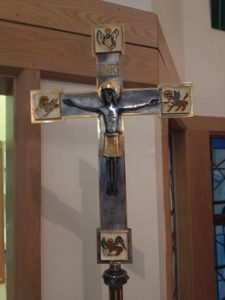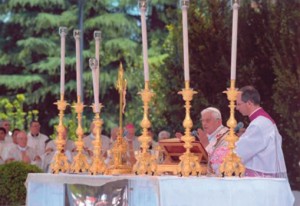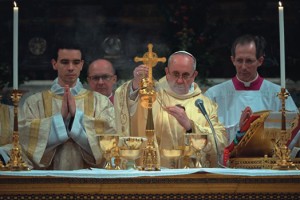The Sanctuary Cross
There are fashions in liturgy as in all human endeavours. The look of vestments changes from one decade to the next, the style of furnishings and decoration varies according to the tastes of those responsible for organizing them. Liturgy is innately conservative and the pace of change is usually quite slow, but anything alive undergoes change.
One recent fashion is evidence of the considerable influence a single person with an important teaching role can have.
In the year 2000, as Cardinal and head of the Congregation of the Doctrine of the Faith, Joseph Ratzinger, wrote The Spirit of the Liturgy and, in a discussion about the ancient practice of praying towards the East, advocated the following:
Where a direct common turning towards the east is not possible, the cross can serve as the interior “east” of faith.
It should stand in the middle of the altar and be the common point of focus for both priest and praying community. In this way we obey the ancient call to prayer: “Conversi ad Dominum,” “Turn to the Lord!”
In 2005 Joseph Ratzinger became Pope Benedict XVI. His writings were republished and reached a much wider audience. The papal liturgies soon embodied his liturgical ideas and in these days of the global media were seen by many millions of Catholic throughout the world. The image of the Pope celebrating mass at an altar with a row of large candles and a central crucifix facing him was widely diffused. This practice has also been visible in some of the papal liturgies with Pope Francis.
Popes influence the liturgy of the Church by their example, by their teaching and through liturgical instructions. The teaching behind what has been dubbed the “Benedictine arrangement of the altar” was personal to Cardinal Joseph Ratzinger. Pope Benedict promoted the idea by his example, but neither he nor Pope Francis changed the liturgical rules. The General Instruction of the Roman Missal has references to the cross in the sanctuary. The key paragraphs are these:
117. […] On or close to the altar, there is to be a cross with a figure of Christ crucified. The candles and cross adorned with the figure of Christ crucified may also be carried in the Entrance Procession. […]
122. […] The cross adorned with a figure of Christ crucified and perhaps carried in procession may be placed next to the altar to serve as the altar cross, in which case it ought to be the only cross used; otherwise it is put away in a dignified place.
And in the section on the arrangement of the sanctuary:
308. There is also to be a cross, with the figure of Christ crucified upon it, either on the altar or near it, where it is clearly visible to the assembled congregation. It is appropriate that such a cross, which calls to mind for the faithful the saving Passion of the Lord, remain near the altar even outside of liturgical celebrations.
The General Instruction envisages a single crucifix, clearly visible to the congregation, on or near the altar and suggests that the procession cross could serve as this cross. If there is a large fixed crucifix, then the procession cross is not left on display in the sanctuary. There is a liturgical principle that a single good instance of a thing should be displayed rather than multiple examples. On the basis of this, a sanctuary with a suspended crucifix or a large one attached to the wall should not also have an altar cross on display. When incense is used “the” cross and the altar are incensed. The primary symbols of the eucharist are the bread and wine and these should not be obscured.
Our Popes have given us a liturgical example and encouraged us to focus our prayer on the crucified Lord, whose liturgy it is, who lifts us up to the Father. They have not changed the liturgical instructions, perhaps to leave room for debate and for adaptation to different spaces and contexts. A giant televised papal mass is different from a small parish eucharist and the scale and placement of the symbols used can and should differ.



 Entries(RSS)
Entries(RSS)